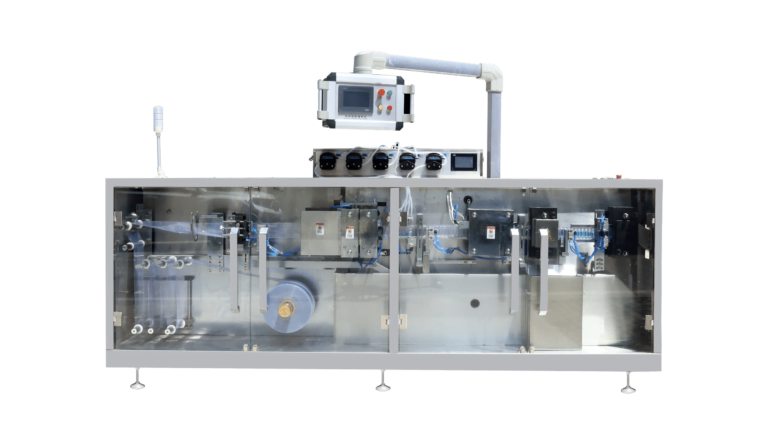Horizontal Form Fill Seal (HFFS) machines are a type of packaging equipment used to create flexible pouches or bags, fill them with a product, and then seal them closed. They are commonly used in the food, pharmaceutical, and consumer goods industries for packaging a wide range of products such as snacks, liquids, powders, and more.
Here’s an overview of how automatic HFFS machines work:
- Film unwind and tension control: The machine starts with a roll of flexible packaging film, which is unwound from a reel. Tension control devices help maintain proper tension on the film as it is fed through the machine.
- Forming: The film is fed through a forming assembly, which shapes the film into a continuous tube. This is typically done using a forming collar (also known as a forming shoulder or forming tube) that wraps the film around itself, with the edges of the film overlapping.
- Sealing: Once the film is formed into a tube, a vertical sealing mechanism (usually a heated sealing bar or ultrasonic sealing system) seals the overlapping edges of the film, creating a continuous “fin seal” along the back of the tube.
- Filling: As the film tube moves through the machine, a filling system (such as an auger filler, piston filler, or volumetric filler) dispenses the product into the tube. The filling system is synchronized with the movement of the film to ensure accurate and consistent filling.
- Horizontal sealing and cutting: After the product is filled into the tube, a horizontal sealing mechanism (again, typically a heated sealing bar or ultrasonic sealing system) creates a transverse seal above and below the product, forming individual pouches. Simultaneously, a cutting mechanism (such as a knife or rotary cutter) separates the pouches from each other.
- Discharge and optional printing: The completed pouches are then discharged from the machine, usually onto a conveyor belt or into a collection bin. Some HFFS machines also include optional printing systems that can print product information, barcodes, or other data directly onto the pouches during the packaging process.
The entire process is automated and typically controlled by a programmable logic controller (PLC) or other computerized control system. This allows operators to easily adjust various settings, such as sealing temperatures, filling volumes, and machine speed, to accommodate different packaging materials, product types, and production requirements.
In summary, automatic HFFS machines work by unwinding a flexible film, forming it into a continuous tube, sealing the edges, filling the tube with the product, sealing and cutting individual pouches, and finally discharging the finished pouches. The process is fast, efficient, and versatile, making HFFS machines an essential part of many modern packaging lines.




